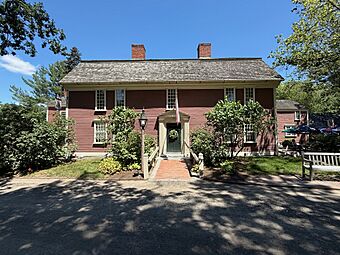Wayside Inn Historic District facts for kids
Quick facts for kids |
|
|
Wayside Inn Historic District
|
|

The Wayside Inn in 2025
|
|
| Location | Sudbury, Massachusetts |
|---|---|
| Built | 1686 |
| Architect | Multiple |
| Architectural style | Greek Revival, Colonial |
| NRHP reference No. | 73000307 |
| Added to NRHP | April 23, 1973 |
The Wayside Inn Historic District is a special area in Sudbury, Massachusetts. It has nine old buildings that are important to history. The most famous building is The Wayside Inn. It is one of the oldest inns in the United States. It started as Howe's Tavern way back in 1716.
This district shows off different building styles. You can see Greek Revival and American colonial architecture. Because of its history, the area was added to the National Register of Historic Places in 1973. This means it is officially recognized as a place worth protecting.
The Wayside Inn: A Historic Stop
The Wayside Inn is a very old place where travelers could rest. It has been open for hundreds of years. Imagine people stopping here long ago, maybe even before the United States was a country! It's a landmark that tells many stories from the past.
Other Cool Buildings and Ford's Projects
Besides the inn, there are other interesting structures in the district. The famous car maker Henry Ford built some of them. He created a working grist mill. A grist mill is a place where grain is ground into flour. He also built a white chapel. It was named the Martha-Mary Chapel, after his mother and mother-in-law.
Ford also tried to build a reservoir, which is a large lake for storing water. This reservoir was meant for the Wayside Inn. It is located across US Route 20 in a wooded area. There is a 30-foot-high stone dam there. People called it "Ford's Folly" because it did not work. The small stream feeding it did not have enough water. Also, the ground was too sandy to hold the water.
In the chapel grounds, you can find the Redstone School. This was a one-room schoolhouse. Henry Ford moved it from Sterling, Massachusetts. He believed it was the actual school mentioned in the poem "Mary Had a Little Lamb" by Sarah Josepha Hale.
The Mass Central Rail Trail—Wayside is a state park. It is about 23 miles long. This trail forms the northeastern edge of the historic district. The "Wayside" part of its name comes from the old Wayside Inn Railroad Waiting Room. This was a train station at the crossing with Dutton Road.
Gallery
-
A marker announcing George Washington's passing through in 1775
-
The inn's grist mill
See also









